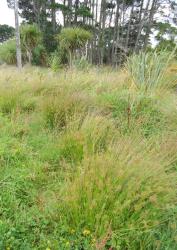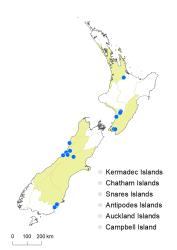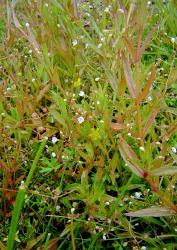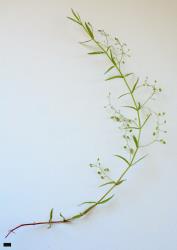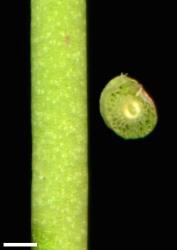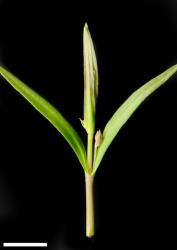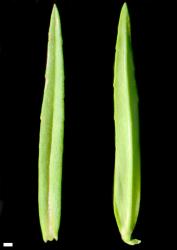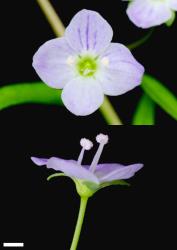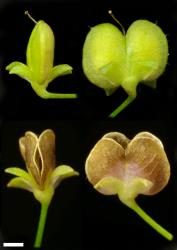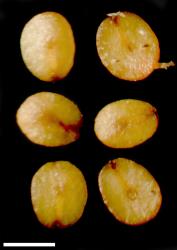Slender, scrambling annual or perennial herb to 0.6 m tall. Stems decumbent to ascending, glabrous. Leaf bud indistinct; leaves separating while very small, opposite-decussate, spreading; lamina thin, linear to very narrow-lanceolate, 20–60 mm long, 1–6 mm wide, sometimes to 12 mm wide, dull pale green to green above, pale green or sometimes reddish-tinged beneath; midrib evident; surfaces glabrous; margin glabrous, entire or minutely toothed; teeth in 5–10 distant pairs; apex narrowly acute to acuminate; base narrowly cuneate, becoming rounded or truncate; petiole absent. Inflorescence a lateral raceme (nearly always 1 per leaf pair), 60–150 mm long; flowers distant, 10–20, all bisexual; bracts alternate, linear, < pedicels; pedicels spreading to reflexed, recurved at apex at fruiting, 5–13 mm long, glabrous. Calyx lobes 4, sub-acute, rounded at very tip, 1.8–2.0 mm long, equal, glabrous. Corolla 5–6 mm diameter; tube greenish and white, c. 1 mm long, < calyx, glabrous inside; lobes 4, pale bluish pink, spreading, sub-equal, orbicular, 2.6–3.0 mm long, rounded; nectar guides short, pale purplish. Stamen filaments white, 1.9–2.3 mm long; anthers white. Style glabrous, 1.8–2.0 mm long. Capsules angustiseptate, deeply emarginate or didymous, glabrous or with a few glandular marginal cilia, 3–4 mm long, 3.5–5.0 mm at widest point. Seeds ellipsoid, flattened, smooth, pale brown, 1.2–1.4 mm long.
V. scutellata plants are easily distinguished from other wetland herbaceous speedwells by their slender, weak, scrambling stems, very narrow leaves, alternating filiform inflorescences, filiform spreading to reflexed pedicels, small pale flowers with rounded corolla lobes, strongly flattened, deeply emarginate to didymous, broadly rounded capsules, and central chalaza on the seeds.
North Island: Auckland (Tīrau), southern North Island (Feilding, near Foxton, Lake Wairarapa).
South Island: Western Nelson (Razorback Point, near Punakaiki, only), Canterbury (upper Waimakariri River), Westland, Otago (Lake Waihola, Lake Tuakitoto).
Wet or marshy places such as ditches and drains, often straggling through taller plants. Recorded elevations range from 5 to 30 m.
Allan (1924, p. 313). Voucher: CHR 3364, H.H. Allan, 12 Mar 1923.
Flowers: December–April; fruits: December–April.
2n = 18 from overseas material (Albach et al. 2008).
Veronica scutellata is classified in V. subg. Veronica (Albach et al. 2004; Albach & Meudt 2010).
Veronica scutellata stems are only 1–2 mm thick with a very narrow, hollow core. The leaf teeth are small, and appear to face backwards towards the petiole, an impression enhanced by the prominent hydathode associated with each. The inflorescences almost always arise from just one of the two leaves of a pair (distinguishing it from other aquatic species, where two or more inflorescences are produced per node). The capsules open loculicidally only. The chalaza of the seed is at about the middle, unlike V. anagallis-aquatica and V. catenata, where it is off centre.



